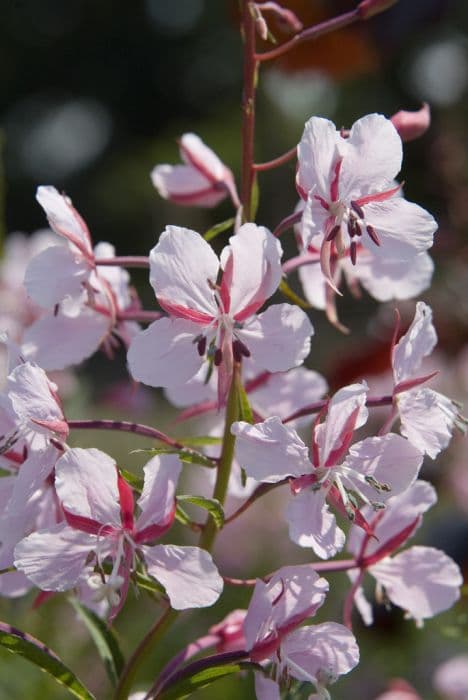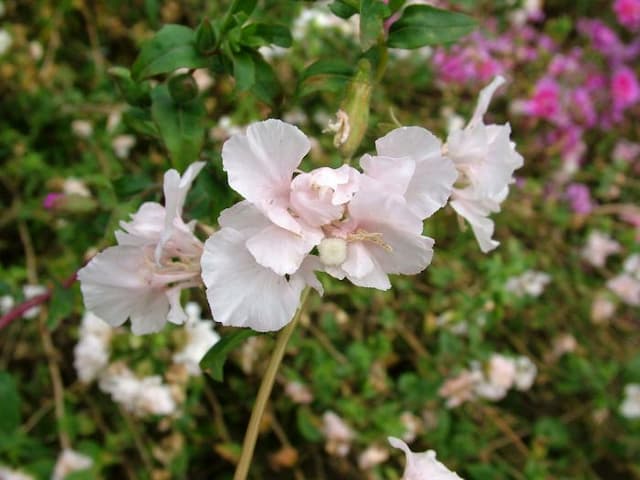Fuchsia Fuchsia 'Rose of Castile Improved'

ABOUT
The Fuchsia 'Rose of Castile Improved' is a charming plant, known for its delicate and ornamental appearance. The plant showcases a profusion of exquisite pendant-like flowers, which provide a burst of color throughout its blooming season. These blooms are distinctive, with a two-tone color palette that typically presents a graceful combination of soft pink and a deep, vibrant purple. The outer petals, known as the sepals, are usually long and slender, displaying a lovely pink hue that can range from pale to a more saturated rosy shade. Elegantly contrasting these, the inner skirt-like petals, or the corolla, unfurl into a bold purple, sometimes with tones leaning towards magenta. The corolla is often fuller and ruffled in appearance, adding a sense of volume and depth to the overall flower structure. The foliage of the Fuchsia 'Rose of Castile Improved' comprises small to medium-sized green leaves that are somewhat elongated with a subtle serrated edge. The leaves are often arranged oppositely along the stems, creating a bushy and dense canopy of greenery from which the spectacular flowers dangle. Overall, the 'Rose of Castile Improved' boasts a graceful, cascading habit that makes it an ideal choice for hanging baskets or as a feature in a container garden where its delightful flowers can be admired up close. With its enchanting flowers and lush foliage, this variety of Fuchsia is sure to add a touch of romance and old-world charm to any garden space it graces.
About this plant
 Names
NamesFamily
Onagraceae
Synonyms
Rose of Castile Improved, Lady's Eardrops, Fuchsia
Common names
Fuchsia 'Rose of Castile Improved'.
 Toxicity
ToxicityTo humans
Fuchsia, including the 'Rose of Castile Improved', is generally considered non-toxic to humans. However, if any parts of the plant are ingested in large quantities, they might cause mild gastrointestinal discomfort such as nausea, vomiting, or diarrhea.
To pets
Fuchsia, including the 'Rose of Castile Improved', is typically considered non-toxic to pets such as dogs and cats. Ingesting this plant should not cause serious harm to your pets. However, some animals might experience mild gastrointestinal upset if they consume large amounts of the plant.
 Characteristics
CharacteristicsLife cycle
Perennials
Foliage type
Deciduous
Color of leaves
Green
Flower color
Mixed
Height
2 feet (0.61 meters)
Spread
2 feet (0.61 meters)
Plant type
Shrub
Hardiness zones
9
Native area
Central America
Benefits
 General Benefits
General Benefits- Attractive Flowers: Fuchsia 'Rose of Castile Improved' produces beautiful, pendant-like flowers that are highly decorative and add visual appeal to any garden or outdoor space.
- Long Blooming Season: This plant offers a prolonged blooming season, generally from spring through fall, providing a long-lasting display of color.
- Habitat for Pollinators: The flowers of the Fuchsia plant attract hummingbirds, bees, and other pollinating insects, helping to support local ecosystems.
- Versatility: It is suitable for growing in containers, hanging baskets, and borders, making it a versatile choice for different garden designs and spaces.
- Shade Tolerance: Unlike many other flowering plants, Fuchsia 'Rose of Castile Improved' can tolerate partial shade, making it an excellent choice for shaded gardens.
- Easy Propagation: Fuchsia plants can be easily propagated from cuttings, allowing gardeners to create more plants for their garden or to share with others.
- Immediate Impact: Fuchsia 'Rose of Castile Improved' can provide an immediate impact in the garden due to its growth habit and prolific flowering.
 Medical Properties
Medical PropertiesThis plant is not used for medical purposes.
 Air-purifying Qualities
Air-purifying QualitiesThis plant is not specifically known for air purifying qualities.
 Other Uses
Other Uses- Fuchsia can be used as a natural dye, where the petals of the 'Rose of Castile Improved' may provide a unique hue to fabrics or crafts.
- Crushed fuchsia leaves can serve as an insect-repellant, potentially deterring pests such as aphids when sprinkled around other susceptible plants.
- The plant may be used in floral arrangements not just for its flowers but also for its appealing foliage, adding a touch of elegance to bouquets.
- Fuchsias can be incorporated into educational activities for children to learn about plant biology and pollination by observing the plant's interactions with pollinators.
- The cascading branches of Fuchsia 'Rose of Castile Improved' make them suitable for creating living curtains or dividers in an outdoor space.
- As a subject in photography, the intricate blooms of fuchsias can provide a stunning focal point for botanical photographers.
- The plant can be used in creating bonsai, an art form that involves growing and shaping miniature trees, due to its attractive structure and flowering habit.
- Fuchsia flowers can be floated in decorative water bowls for a festive table centerpiece or to create a tranquil setting.
- When dried, the blooms and leaves of fuchsias can be used to make natural potpourri blends, contributing both scent and color.
- Gardeners might use fuchsia plants to create a "Fairy Garden," as their delicate flowers are often associated with whimsy and are attractive to children and adults alike.
Interesting Facts
 Feng Shui
Feng ShuiThe Fuchsia is not used in Feng Shui practice.
 Zodiac Sign Compitability
Zodiac Sign CompitabilityThe Fuchsia is not used in astrology practice.
 Plant Symbolism
Plant Symbolism- Confiding Love: The hanging blooms of the Fuchsia often symbolize confiding love, the way they seem to trustingly dangle can represent a deep trust and sentiment between individuals.
- Elegance and Good Taste: The grace and unique beauty of the Fuchsia bloom is symbolic of high elegance and good taste, making them often sought after by those with a keen eye for aesthetics.
- Amiability: With its friendly appearance, the Fuchsia is often associated with amiability and warmth in relationships.
 Water
WaterFuchsia 'Rose of Castile Improved', commonly known as hardy fuchsia, should be watered thoroughly, ensuring that the soil is kept consistently moist but not waterlogged. During the growing season, it's common to water the hardy fuchsia about once or twice a week, adjusting for climate and weather conditions. As a guideline, provide about 16-32 ounces of water per week, depending on the size of the plant and the environmental conditions. It’s crucial to reduce watering frequency in the winter months when the plant is not actively growing.
 Light
LightHardy fuchsia thrives in a spot that provides bright, indirect light with protection from the harsh afternoon sun. A position where it can receive morning sunlight and afternoon shade is optimal for its growth. Direct, strong sunlight can scorch the delicate foliage and blooms, so a partially shaded area is best for the hardy fuchsia.
 Temperature
TemperatureThe hardy fuchsia prefers a cool to moderate temperature range, ideally between 55°F and 75°F. It can survive minimum temperatures down to about 40°F for short periods. However, the plant should be protected from extreme heat and frost, so temperatures below 40°F or above 80°F can be detrimental to its health.
 Pruning
PruningPrune hardy fuchsia to maintain its shape, encourage bushier growth, and remove any dead or damaged wood. The best time to prune is in late winter or early spring before new growth starts. It's advisable to prune annually, cutting back about one-quarter to one-third of the previous year's growth to stimulate healthy new shoots.
 Cleaning
CleaningAs needed
 Soil
SoilFuchsia 'Rose of Castile Improved' thrives best in a well-draining soil mix with peat moss, loam, and perlite or sand in equal parts. The ideal soil pH for this fuchsia should be slightly acidic to neutral, ranging from 6 to 7.
 Repotting
RepottingFuchsia 'Rose of Castile Improved' should be repotted annually or when the plant outgrows its current container, ensuring that it continues to have ample space to grow and receive fresh nutrients from new soil.
 Humidity & Misting
Humidity & MistingFuchsia 'Rose of Castile Improved' prefers high humidity conditions, ideally between 60% to 70%, to thrive and produce its beautiful blooms.
 Suitable locations
Suitable locationsIndoor
Place in bright, indirect light, keep moist and in high humidity.
Outdoor
Partial shade, shelter from wind, keep soil moist but drained.
Hardiness zone
10-11 USDA
 Life cycle
Life cycleFuchsia 'Rose of Castile Improved', commonly known as hardy fuchsia, begins its life cycle as a seed that germinates in a warm, moist environment, typically in spring. Once sprouted, the seedling grows into a young plant, developing a root system and foliage. As the plant matures, it produces characteristic drooping flowers in shades of pink and purple, which attract pollinators during the blooming season, usually in the late spring through summer. Following pollination, the flowers develop into small fruiting bodies containing seeds, completing the reproductive cycle. In colder climates, the plant dies back to the ground in winter, entering a dormant phase, but in milder areas, it may retain some of its woody structure. With proper care, including pruning and protection from extreme cold, the hardy fuchsia can continue its life cycle for several years as a perennial.
 Propogation
PropogationPropogation time
Spring-Early Summer
Propogation: The Fuchsia 'Rose of Castile Improved', commonly referred to as fuchsia, is typically propagated through softwood cuttings. This method involves taking a young, soft stem from the plant during late spring or early summer when the plant is actively growing. The chosen stem should be about 2 to 4 inches (5 to 10 cm) long and have a few leaves. The lower leaves are removed, and the cut end is dipped in rooting hormone powder to enhance root development. The treated cutting is then inserted into a pot filled with moistened potting mix and covered with a plastic bag or placed in a propagator to maintain high humidity. Cuttings are kept in a warm, bright location out of direct sunlight, and in a few weeks, they should develop roots and can be transplanted into individual pots.









